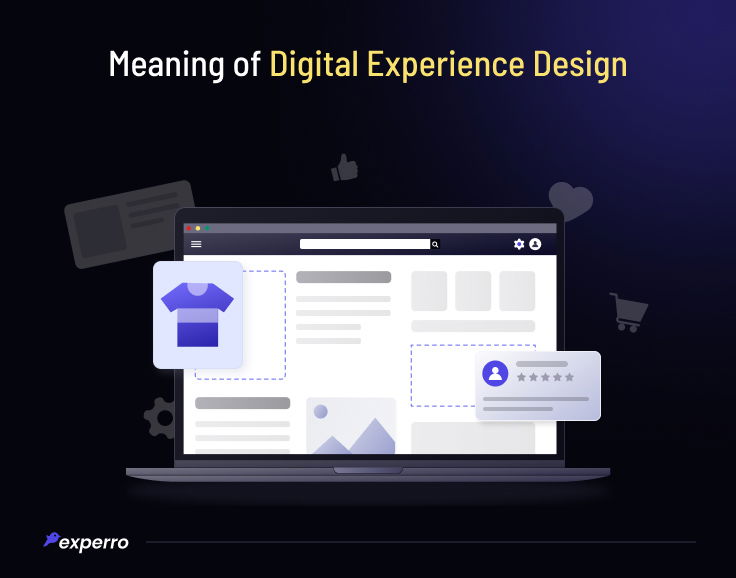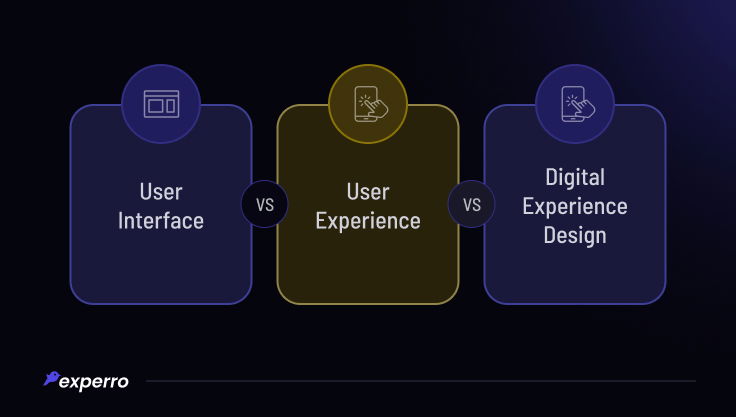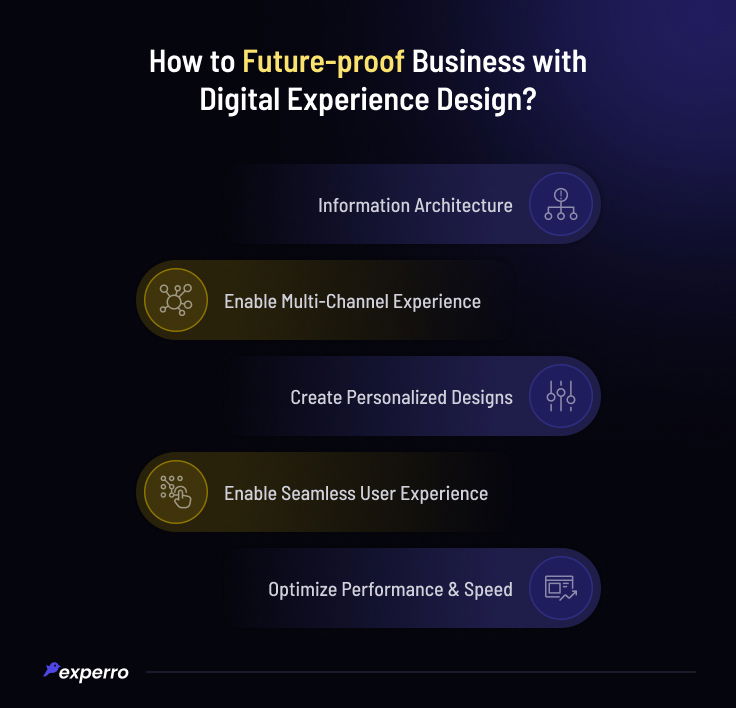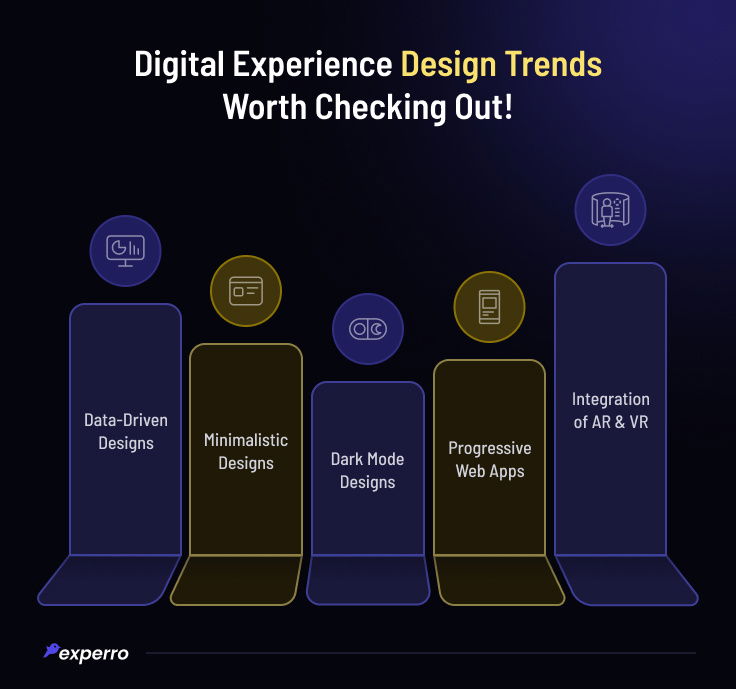How Digital Experience Design Drives Higher Conversion?

What’s Inside
- What Is Digital Experience Design?
- Difference Between UI, UX, and Digital Experience Design
- How to Create Digital Experience Design That Aligns with Customer Journey?
- How to Future-Proof Business with Digital Experience Design?
- What Are the Popular Digital Experience Design Trends?
- What Are the Digital Experience Design Best Practices?
- What Are the KPIs to Measure the Effectiveness of Digital Experience Designs?
- How Experro Enables Better Customer Experience with Digital Experience Designs?
- Conclusion
Key Takeaways
- Digital experience designs create a captivating environment that keeps users engaged on the platform.
- Thoughtful digital user experience design choices lead to a higher level of customer satisfaction, leaving a lasting impression on users.
- The elements of designing digital experiences include UI, UX, content, and information architecture.
- Connecting customer journeys with digital experience design creates a seamless and tailored user experience.
- Experro DXP helps businesses create exceptional digital experience designs that truly win the hearts of customers.
The digital experience design is crucial as it shapes how users interact with your brand.
It acts as the blueprint for creating user-friendly and engaging websites. When implemented effectively, it ensures that users can navigate, understand, and accomplish tasks easily.
Designing digital experiences also plays a significant role in building brand perception and trust.
If users have a positive experience, they are more likely to trust the brand and continue using its products or services. Additionally, effective designs increase the chances to convert potential customers.
If you are a digital experience designer, digital marketer, or digital strategist, this blog is for you.
In this blog, we will learn about the importance of digital experience designs. We will also explore the digital experience design trends and ways to connect it with the customer journey for better results.
So, without further ado, let’s first understand the meaning of digital experience design.
What Is Digital Experience Design?

Digital experience design refers to the process of creating user-friendly and engaging digital products and platforms like websites.
It focuses on enhancing the user experience through appealing designs and navigation.
Digital experience design aims to delight customers by creating intuitive, seamless, and engaging digital experiences.
Whether it's a B2C or B2B digital experience design, the whole process extends beyond creating appealing aesthetics and delves into creating a consistent experience for customers.
Difference Between UI, UX, and Digital Experience Design

Although UI, UX, and digital experience design all three of these contribute to the brand image, they are different in nature.
User interface design refers to the visual elements and interactive components of a product or a system. It includes elements like buttons, menu icons, and layout designs.
There is a difference between digital experience vs user experience. Digital experience design is a more comprehensive term in comparison to UI design and UX design.
It encompasses the entire digital journey of a user, including interaction with the website, social media, and other digital touch points.
On the other hand, digital user experience design encompasses the experience the user has while interacting with a product or a system. It includes factors like navigation, ease of use, accessibility, and usability.
Digital experience design includes both user interface and user experience as elements and encompasses the holistic view of digital interaction a user has with the brand.
How to Create Digital Experience Design That Aligns with Customer Journey?
We at Experro believe in placing users at the center of the design process.
The customer journey refers to the entire process and experience that a customer goes through when interacting with a brand.
In the digital forefront, it includes customer engagement with your website and other multiple digital channels.
Aligning design for digital experience with the entire customer journey is crucial to enable tailored customer experiences. It will allow businesses to provide exactly what the customer is looking for.
The following points explain how to create digital experience design framework that aligns with customer journey.
1. Research Customer Needs
Researching customer needs is the first step towards connecting digital experience design with your users.
It includes tracking customer history, the purchase process, and website visits through analytics and insights.
This will help you to understand how customers interact with your brand and how they make a purchase decision.
Based on the customer data, marketers can create a digital content strategy that helps them reach the target audience.
For instance, through comprehensive research, marketers identified that more customers are looking for oval-shaped diamond rings on the website. Through this information, they can identify the inventory needs and marketing campaign requirements for products.
2. Create Customer Journey Maps
Mapping customers' journey stages include identifying where customers are interacting with your products or web pages from.
This includes tracking buyer journey on different social media channels, links, blogs, and other website pages.
At each stage of the buyer's journey, marketers can identify what activities customers come across and what motivates them to make a purchase during the buying process.
They can also analyze customer journeys and identify if there are any challenges customers face during their whole journey.
3. Optimize for Seamless Digital Experience
Did you know a total of 83% of users believe that having a smooth experience on different devices is important?
Ensure a seamless transition between numerous digital touchpoints.
This involves ensuring that the customer enjoys the process even after changing the digital channel or device. This means users should feel like they are picking up where they left off, regardless of their medium of interaction.
Seamless digital experiences increase customer loyalty and encourage them to spread positive word of mouth.
How to Future-Proof Business with Digital Experience Design?

The following points highlight how to secure business with better digital experience designs:
1. Information Architecture
The information architecture involves creating a clear navigation path for users, content hierarchy, etc. It should enable users to navigate the site easily and find what they are looking for without any hassle.
This includes organizing content into a logical hierarchy and ensuring a consistent and user-friendly system.
2. Enable Multi-Channel Experience
57% of consumers expect companies to provide consistent experiences on different customer touchpoints.
Gone are the days when websites were the single source of interaction for customers with the brand. This is the era of social media, mobile apps, and IoT (Internet of Things) devices.
Providing seamless user experience on multiple digital channels enables a connected customer experience. Additionally, it not only enhances digital-user-experience but also increases brand value.
3. Create Personalized Designs
Personalization always wins the hearts of customers.
Did you know that 80% of consumers are more likely to buy from a company that offers personalized experiences? Personalized designs for digital experiences catered to individual user preferences make the customer experience more relevant and engaging.
- Advantage 1 - This can lead to higher user satisfaction and increased time spent on your website.
- Advantage 2 - Moreover, it leads to better customer relationships.
TIP – Experro enables businesses to create personalized landing pages on the basis of user preferences.
4. Enable Seamless User Experience
No matter from which device or which digital channel your customer is interacting with your brand, you should be able to provide a seamless user experience on different digital interactions.
This means that the user experience on multiple channels such as mobile devices, desktop tablets, or any other platform should remain consistent.
As a greater number of people are using mobile devices over desktops, making your website compatible with mobile designs is recommended.
Creating mobile-first website experiences for customers enhances user engagement rates and satisfaction.
5. Optimize Performance and Speed
An interesting statistic says that 1 out of 4 visitors are likely to leave a website that takes more than 4 seconds to load.
No matter how much effort you have put into your design, if your website is not optimized for better speed performance, it will all go in vain. Moreover, it affects the overall quality of the customer life cycle.
That's why digital experience through web design must be optimized for speed.
TIP – Leverage a cutting-edge headless CMS for fast-loading stellar websites.
What Are the Popular Digital Experience Design Trends?

Following are the top five digital experience design trends worth checking out:
1. Data-Driven Designs
Data-driven customer insights always help organizations provide tailored recommendations for their customers. Data helps in understanding user behavior preferences and pain points.
This customer information allows designers and marketers to deliver content to meet the specific needs of the target audience.
2. Minimalistic Designs
Creating digital experiences by utilizing minimalistic designs signifies simplicity and clarity, reducing visual clutter. This allows users to reduce destruction while navigating the website.
It has fewer elements and more clarity. Moreover, with minimalistic designs, users can focus on core content rather than other elements.
3. Dark Mode Designs
Did you know approximately 22% of the web traffic comes from users who prefer dark mode settings?
Dark mode designs improve the readability of fonts and elements on the website. Text on a dark background often provides a higher contrast, making the text more readable and eligible.
It is also beneficial for a low-light environment when users want to use the website at night.
4. Progressive Web Apps (PWAs)
Progressive Web Apps are designed to work seamlessly across various platforms and devices, providing a consistent user experience regardless of the operating system and browser.
Moreover, they are optimized for speed and performance, offering fast loading times and smooth interactions.
Do you know what’s the best part? The PWAs can even work in offline mode. They provide an app-like experience within the browser environment.
It eliminates the need for users to go to the app store and download the app and still give the app-like experience.
5. AR (Augmented Reality)
Going beyond traditional interface with AR is the hottest trend in the market. It helps to create more engaging and interactive user experience.
Augmented reality allows users to instantly see and experience products in real-time, empowering them to make swift decisions. It fosters interactive digital experiences by encouraging users to actively engage with the products.
Additionally, this trend can be used to create personalized experiences based on user preferences and behavior.
For instance, users can visualize hair color products on their own image in real-time, boosting their confidence in making a purchase.
We have written a detailed blog on DXP trends for you to get an overall idea.
What Are the Digital Experience Design Best Practices?
The best practices for creating digital experience design are as follows:
- Prioritize the needs and preferences of your target audience.
- Provide users with intuitive navigation and pathways to explore your digital product easily.
- Ensure your design works seamlessly on various devices and screen sizes.
- Optimize load times and responsiveness to enhance the user experience.
- Develop a personalized content strategy to deliver relevant and engaging information.
- Protect user data and privacy through robust security measures.
- Continuously update and refine your design based on user feedback and evolving technologies.
What Are the KPIs to Measure the Effectiveness of Digital Experience Designs?
The following are the key performance indicators to measure the effectiveness of your digital experience design:
1. User Engagement
User engagement is the most effective indicator to measure the effectiveness of digital experience design. It’s the way individuals interact with your brand. It can include user interaction with websites, social media, or mobile applications.
User engagement can be measured with KPIs such as visitors' time spent on a page, session duration, likes and comments on social media pages, etc.
2. Click-Through Rate
Click-through rates are the valuable matrix that provides detailed insights into how actively a user is interacting with your brand.
It represents the percentage of users who click on a particular link, e-mail, or social media post.
A high click-through rate indicates that users are engaging well with your website. Vice versa, a low click-through rate indicates users are not engaging with your brand.
3. Conversion Rate
Conversion rates are the total number of users who successfully purchased from your website. It directly measures the impact of your digital experience design.
When users seamlessly navigate the website without experiencing any friction, it creates a positive experience. This increases the likelihood of conversions and fosters a lasting connection between users and the brand.
4. Customer Satisfaction
Customer satisfaction is also one of the effective measurements of digital experience design. It can be measured by asking for feedback or direct conversation.
If customers are providing positive feedback, they are more likely to return to the website and make a purchase again.
If customers are not satisfied with the experience and provide negative feedback, they will not return to the website.
Brands can identify potential gaps in the product and service and make changes accordingly.
5. Churn Rate
The churn rate is the number of users who stopped using products over time. A high churn rate indicates that users are having a poor experience and leaving the product.
Businesses can use this information to improve the customer experience and their marketing efforts.
How Experro Enables Better Customer Experience with Digital Experience Designs?
Experro DXP is a holistic platform that provides a set of features to create the best digital experience designs.
It offers a robust headless CMS that centralizes customer data from multiple touch points such as websites, social media, and mobile applications. This provides designers with a comprehensive view of user behavior and preferences.
Experro empowers businesses to create tailored and personalized digital experiences that deeply resonate with each customer.
Additionally, it provides features like analytics and insights to gain knowledge about customer interaction with your brand.
Conclusion
Digital experience designs are the most crucial aspect of the online world. It’s the place where every customer touchpoint counts.
Improving digital experience design with the help of the right technology allows businesses to unlock their fullest potential and create exceptional customer experience.
To create such a stellar digital experience design and improve your business success and customer’s experience, book a call with Experro.
FAQs


Priya Zala
13 June 2024Through her writing, she has a lovely way of capturing users' pain points and delivering solution-oriented content. Her writing is sure to captivate readers and leave them with a lasting impression. When not crafting content, Priya enjoys getting lost in a good work of fiction, which soothes her soul.